My Place: at home in LA with Jessy Lanza
The Canadian artist and producer shows us around the house where she created new album Love Hallucination
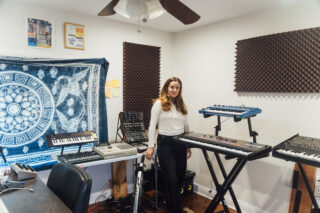
The Canadian artist and producer shows us around the house where she created new album Love Hallucination
Jessy Lanza started making her fourth album when she was living with her in-laws in the Bay Area, but a majority of Love Hallucination came together once she and her husband had moved to Silver Lake in north-east LA at the start of 2022. Her house is up the hill, with no other properties sharing any of its walls – typical for LA but a novelty for Lanza who’d been used to apartment living in New York since she’d left her hometown of Hamilton, Ontario: a “chip-on-its-shoulder rust belt city,” she called it when she last spoke to Loud And Quiet, in 2020.
“When I think of Pull My Hair Back,” she says of the debut album that first introduced us to her sultry brand of gossamer slow jams a decade ago, “which was made when I was still in Hamilton, my studio was above a bar, so I would take breaks and go there and someone would say something weird to me, and I would take it back upstairs and put it in a song.”
Just three weeks after moving to LA, Lanza narrowly avoided being hit by a car. She turned that experience into Love Hallucination opener ‘Don’t Leave Me Now’ – a classic Jessy Lanza club track operating from the more skittering techno-pop end of what she does so incredibly well.
“I think a lot of the bravado of LA, and the confidence it takes to be a part of it, I think that definitely shows up in this record,” she says. When I say that I thought New York was supposed to be America’s unforgiving city and LA its much softer, relaxed counterpart, Lanza says: “I think that’s such bullshit that people are relaxed in LA [When that car nearly ploughed into me] I definitely felt a physical manifestation of the ‘Fuck you, get out of my way’ attitude that can permeate parts of Los Angeles.”
Later on the album, ‘Drive’ explores not the terrors of driving but the romance of it, which seems wholly fitting considering how perfect Jessy Lanza’s music has always sounded through a car stereo. ‘Drive’ taps into the freedom of cruising around wherever you please, but the lovelorn two-step of ‘Midnight Ontario’ does the job just as well. All of the tracks on Love Hallucination do, which take turns mining elements of techno, soul, funk, footwork and garage, always with an understated, unhurried assurance that’s made Lanza the queen of slow-burn R&B since the release of Pull My Hair Back. It’s music that turns the air hot; sensual and subtle, even when Lanza lays down a vaguely tropical chillwave beat on ‘I Hate Myself’ and repeats the song’s title as a self-loathing mantra. Her delay pedal vocals add to the allure and sexual charge, still resembling the breathy falsetto of Janet Jackson, Aaliyah and Elizabeth Fraser from Cocteau Twins.
But a key difference here is how Love Hallucination was written. Or half of it, at least. With a handful of tracks still needed to complete the album, Lanza says she “dipped into my rejected pile” – of songs that she’d written for other artists for the first time. Like ‘Marathon’, which features a somewhat out-of-character saxophone solo. She says she would have never included that in a song she knew she was writing for herself (or added the rap, or sung explicitly about orgasms) but writing for others was freeing. “And the ones that ended up on the album just fit, because they’re written at the same time,” she says.
Of course, I asked who ‘Marathon’ was originally intended for, but Lanza will only go as far as telling me they were an R&B/hip-hop group. It’s fair enough. And so she shows me around her home and home studio where Love Hallucination was made.
This is my home studio, which is pretty new, because we didn’t move that long ago. It’s a studio in progress, and I’m pretty particular about where things go. This is where I wrote a lot of tracks for the new album. I’m pretty bad at keeping a constant routine, so my studio hours change all the time. But I record all my vocals in this room – early evening is a good time for me; I’m not really a morning person. And thankfully we don’t share a wall with a neighbour, which I did when I lived in New York. I could hear whenever my neighbour had walked into his room on the other side of the wall, and that would make me feel really inhibited.
I got this EWI [electronic wind instrument] recently, and I got really into practising that, but only on my couch. It’s basically a synthesiser in the shape of a clarinet, with the fingering of an alto saxophone. There’s a sax solo on the new record, which I really wanted to be able to play live, so I learned the sax solo and bought this for the tour, because it wasn’t practical for me to bring a sax on tour.
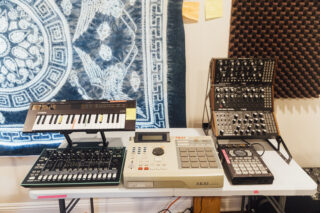
The MPC over here is one of the very first pieces of gear that I bought. That and the Juno 106. These are on all of my records, and the reason I bought the MPC was because I’d read an article on [footwork pioneer] DJ Rashad, and I was such a huge fan of his, and I loved his album Double Cup, which inspired me to want to make music. I read that he used one and just went out and bought one, because I wanted to be like him, basically.
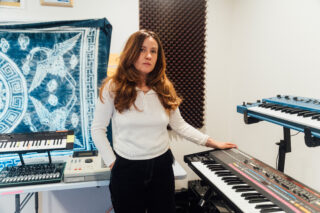
And the 106 Juno is just one of those classic synths that you hear everybody talk about how you can’t beat the sound and there’s no plugin to match it. It’s just a classic synth pop synthesiser, and I saw one on Craigslist really cheap. It’s pretty incredible how expensive those Roland synths have become. It’s a beautiful instrument to have, and it’s a lot of money to keep the voice chips going, but it’s very special and it makes me feel good to have it and touch it, rather than using my mouse.
I don’t think the music I make is close to the type of music I imagined I’d make when I bought either of these, but I think that’s because my imagination isn’t so great. My music definitely doesn’t sound like footwork music, but with this last record I was listening to a lot of sophisti-pop records, like Prefab Sprout, China Crisis, so on this record, yeah, I think the Juno 106 helped to push me to that synth pop place. But with the Juno you don’t have to do much to it to make it sound really good, which is something I thought about a lot on this record – getting really nice sounds from the start.
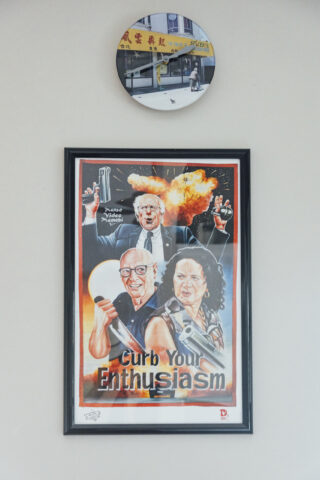
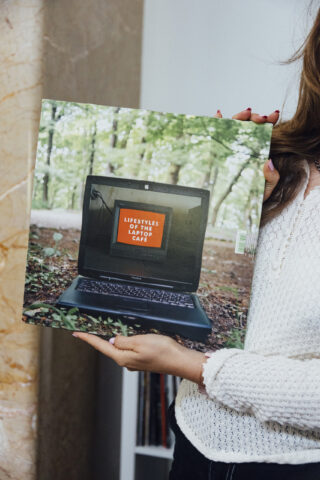
The clock was a gift from our friends in San Francisco. During the pandemic when we couldn’t see anybody other than family and very close friends, we had dinner with them on a weekly basis, and we’d always have dinner at a Sichuan restaurant called Spices. When we left the Bay Area they got us this clock, which is a picture of the Spices II, their other Spices location.
On here we have Rupert Murdoch and Susie Essman. This is a poster from Ghana. We have a really good friend who works for [American cinema chain] Alamo Drafthouse, and they have these posters from Ghana where they paint images on sacks to advertise movies, and make them seem more exciting so people will come to see them. The company is called Manso Video Mamobi, and this was a gift from our friend who works at Alamo Drafthouse. I just like how Bernie Sanders is holding a grenade; Susie Essman’s in there too – I love her. It just makes me smile whenever I see it. I mean, the picture is from nothing at all – it’s just an imagined thing, from someone thinking how can we get people to come and see Curb Your Enthusiasm. It makes no sense.
This is one of my favourite records. A fan actually gave it to me at a show in Philadelphia, and it’s one of the most thoughtful gifts. I think they read in an interview that they were a huge inspiration for me, and this vinyl is hard to get your hands on. The guy who made it [James Stinson] was one half of [Detroit techno duo] Drexciya, and this record is like Detroit electro but he sings on it as well, so there are hooks on there. It’s softer than Drexciya, and when I was first starting to make dance music, I was trying to get my head around how to incorporate my voice, and I found this record to be a huge inspiration.
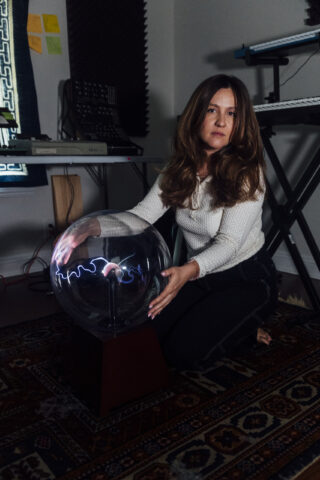
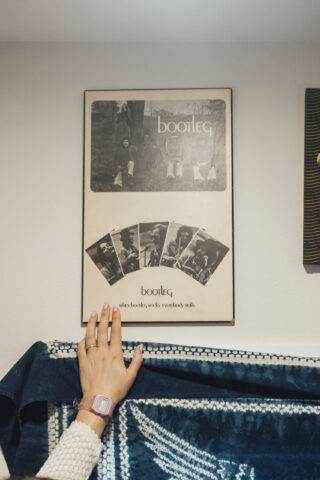
We just call this the electricity ball, and it’s always super fun to shut off all the lights and hang out with the electricity ball for a bit. I find it useful as an anger management tool, in all honesty. We have quite a few nieces and nephews, and it’s really sweet seeing how they react to it. My husband makes music videos, and he bought it for a music video that I don’t think ever came out, but that’s where it came from. It’s probably one of the sweetest items in our house.
This is my parents’ ’70s rock band, Bootleg. My mum is stood against the tree on the left, and my dad is sat in front of her with a really long moustache and a scarf. This photo might have been ’74; they were a rock band who wanted to be Crosby, Stills, Nash & Young, but they were bluesy too. They never pressed anything to vinyl, but they have a lot of reel-to-reels, and a lot of cassette tapes. A project we’re working on right now is archiving my parents’ music. We’re digitalising it all at the moment. But this photo was just for promo, to send to bars and try to get gigs.
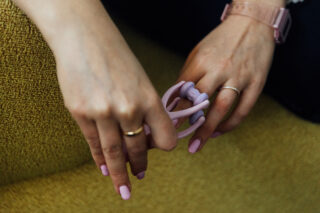
I also love this thing. It’s kind of like the plasma ball – it’s very relaxing and I find if I get a stressful email come in that I want to write something really sassy back to, I just get the finger massager and chill out for a bit. The other technique I’ve been using recently when I get those emails is to take it to the Notes app on my phone and write out the email there. Then I have to go through the extra step of copying and pasting it back into the email, and by then I’ve written out the really harsh, rude version of what I want to say, and it’s out of my system. Out of necessity, I’ve gotten much better at that.
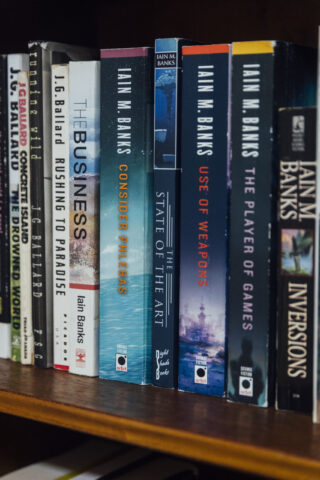
I love science fiction novels, and in particular Iain M Banks. He has a series called the Culture Series, which is about a human civilisation which is symbiotic with machines and AI. Sometimes science fiction, if it goes too hard, it just becomes Star Trek: The Next Generation. Like, ok, you’re just making up a language here. It’s too ridiculous. But Iain Banks always manages to make it human and incorporate existential issues. He walks a pretty delicate line, and I think it’s hard to humanise sci-fi without it becoming Star Wars fantasy, which I don’t like.
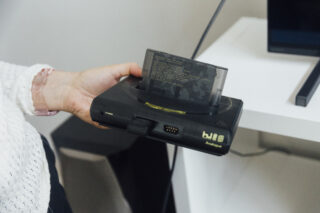
In 2019 Hyperdub did a collab called Konsolation with a company called Analogue. Basically there’s a little flash drive in here where you can play every game that Sega Genesis ever made. But on the cartridge there’s those exclusive tracks you can see [‘Bobby’ by Jessy and Jeremy Greenspan, and tracks by Burial, Ikonika, Kode9 etc.], and that’s the only way you can listen to them – if you put that cartridge in and hook up an aux cable. People have ripped the songs now, but it’s something I was really proud to be a part of, and to do an exclusive track for this weird little console. Only 1000 were made.
My family didn’t have Super Nintendo; we were Sega Genesis, and there are games on here that I hadn’t play since I was 10. Like Altered Beast. It was fun to play those again, because they’re exactly the same. And when you said you wanted to see some objects that mean a lot to you, I instantly thought of this.